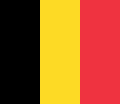
The flag of Suriname was legally adopted on 25 November 1975, upon the independence of Suriname from the Netherlands.

The national flag of Burkina Faso is formed by two equal horizontal bands of red (top) and green, with a yellow five-pointed star resting in the center. The flag was adopted on 4 August 1984. The flag uses the Pan-African colours of Ethiopia, reflecting both a break with the country's colonial past and its unity with other African ex-colonies. The red is also said to symbolize the revolution and the green the abundance of agricultural and natural riches. The yellow star placed over the red and green stripes represents the guiding light of the revolution. The flag was adopted following the coup of 1983 which brought Thomas Sankara to power.

Pan-African colours is a term that may refer to two different sets of colours:

The national flag of Benin is a flag consisting of two horizontal yellow and red bands on the fly side and a green vertical band at the hoist. Adopted in 1959 to replace the French Tricolour, it was the flag of the Republic of Dahomey until 1975, when the People's Republic of Benin was established. The new regime renamed the country and changed the flag to a green field with a red star in the canton. This version was utilized until multi-party democracy was re-established in 1990, coinciding with the Revolutions of 1989. The new government promptly restored the original pre-1975 flag.

The flag of Bolivia is the national flag of the Plurinational State of Bolivia. It was originally adopted in 1851. The state and war flag is a horizontal tricolor of red, yellow and green with the Bolivian coat of arms in the center. According to one source, the red stands for Bolivia's brave soldiers, while the green symbolizes fertility and yellow the nation's mineral deposits.
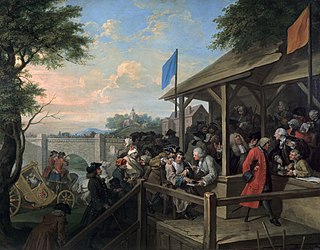
Political colours are colours used to represent a political ideology, movement or party, either officially or unofficially. They represent the intersection of colour symbolism and political symbolism. Politicians making public appearances will often identify themselves by wearing rosettes, flowers, ties or ribbons in the colour of their political party. Parties in different countries with similar ideologies sometimes use similar colours. As an example the colour red symbolises left-wing ideologies in many countries, while the colour blue is often used for conservatism, the colour yellow is most commonly associated with liberalism and right-libertarianism, and Green politics is named after the ideology's political colour. The political associations of a given colour vary from country to country, and there are exceptions to the general trends, for example red has historically been associated with Christianity, but over time gained association with leftist politics, while the United States differs from other countries in that conservatism is associated with red and liberalism with blue. Mass media has driven a standardization of colour by political party, to simplify messaging, while historically the colour a candidate chose to identify with could have been chosen based on other factors such as family or regional variations.

The national flag of the Republic of the Congo consists of a yellow diagonal band divided diagonally from the lower hoist-side corner, with a green upper triangle and red lower triangle. Adopted in 1959 to replace the French Tricolour, it was the flag of the Republic of the Congo until 1970, when the People's Republic of the Congo was established. The new regime changed the flag to a red field with the coat of arms of the People's Republic in the canton. This version was utilized until the regime collapsed in 1991. The new government promptly restored the original pre-1970 flag.

The flag of Ethiopia is the national flag of Ethiopia. It consists of a green, yellow, and red tricolour with the national emblem, a golden pentagram on a blue disc, superimposed at the center. While the colors green, yellow, and red in combination held symbolic importance since at least the early 17th century, the modern tricolour was first adopted on 11 October 1897 by Menelik II, and the present flag on 31 October 1996.
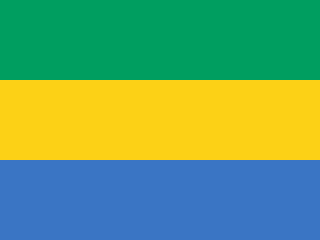
The flag of Gabon is a tricolour consisting of three horizontal green, yellow and blue bands. Adopted in 1960 to replace the previous colonial flag containing the French Tricolour at the canton, it has been the flag of the Gabonese Republic since the country gained independence that year. The design of the present flag entailed the removal the Tricolour and the widening of the yellow stripe at the centre.

The national flag of Guinea was adopted on 10 November 1958, with the publication of the country's first Constitution.

The national flag of Vietnam, formally the National Flag of the Socialist Republic of Vietnam, locally recognized as cờ đỏ sao vàng or cờ Tổ quốc, was designed in 1940 and used during an uprising against the French in southern Vietnam that year. The red background symbolizes revolution and bloodshed. The golden star represents the five main classes in Vietnamese society—intellectuals, farmers, workers, entrepreneurs, and soldiers.

The flag of Senegal is a tricolour consisting of three vertical green, yellow and red bands charged with a five-pointed green star at the centre. Adopted in 1960 to replace the flag of the Mali Federation, it has been the flag of the Republic of Senegal since the country gained independence that year. The present and previous flags were inspired by the French tricolour, which flew over Senegal until 1960.

The flag of Togo is the national flag, ensign, and naval jack of Togo. It has five equal horizontal bands of green alternating with yellow. There is a white five-pointed star on a red square in the upper hoist-side corner. It uses the pan-African colors of Ethiopia, but the design resembles the flag of Liberia, which itself echoes the flag of the United States, making it part of both the pan-African and Stars and Stripes flag families.

"Rwanda Nziza" has been the national anthem of Rwanda since January 1, 2002. It replaced "Rwanda Rwacu", which was the original national anthem until the 1994 genocide against the Tutsis.

Grégoire Kayibanda was a Rwandan politician and revolutionary who was the first elected President of Rwanda from 1962 to 1973. An ethnic Hutu, he was a pioneer of the Rwandan Revolution and led Rwanda's struggle for independence from Belgium, replacing the Tutsi monarchy with a republican form of government. Rwanda became independent from Belgium in 1962, with Kayibanda serving as the country's first president, establishing a pro-Hutu policy and a de facto one-party system governed by his party, Parmehutu. He was overthrown in a coup d'état in 1973 by his defense minister, Juvénal Habyarimana, and died three years later.
"Rwanda Rwacu" was the national anthem of Rwanda from 1962 to January 1, 2002, when it was replaced with "Rwanda Nziza".
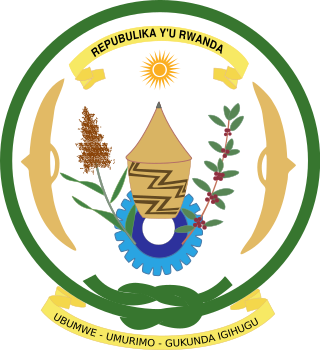
The national emblem of Rwanda is the national symbol and used by the government. It was restyled in 2001 to match the color scheme of the new national flag. The text reads "Republic of Rwanda - Unity, Work, Patriotism" in Kinyarwanda. The central tribal devices, a stem of sorghum, a branch of a coffee tree and a traditional basket are surmounted on a cogwheel with the sun with its rays above, while two typical Rwandan shields protects them, one on the right and one on the left. They are encircled by a square knot.
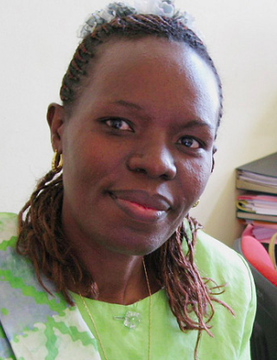
Judith Kanakuze was a Rwandan politician and women's rights activist best known for passing legislation against gender-based violence, including Rwanda's first legal definition of rape, and contributing constitutional gender quotas that required women's representation in governmental bodies. She worked in multiple fields, including nutrition and civil service, before becoming a prominent leader of women after the 1994 Rwandan genocide, in which she lost most of her extended family. Kanakuze founded the early women's organization Réseau des Femmes and represented women's interests at the Arusha Accords and on Rwanda's committee to establish a constitution. The gender quotas that required women to compose at least 30 percent of governmental bodies subsequently quickly spurred women's participation to exceed the quotas in parliament. She was elected to Parliament in 2003 and reelected in 2008. During her terms, she presided over the Rwanda Women Parliamentary Forum.
In the Rwandan Revolution, the coup of Gitarama was an event which occurred on 28 January 1961 in which the monarchy in Rwanda, then a part of the Belgian mandate of Ruanda-Urundi, was abolished and replaced with a republican political system. The traditional monarchy was led by a Mwami (king), who ruled through an administration of chiefs and subchiefs in the context of a feudal system of patron-client relations based on tribute. The Mwami and most of his chiefs were members of the Tutsi ethnic minority, a group which wielded considerable social, political economic power. Of subordinate status to the Tutsis was the Hutu ethnic majority. As part of their rule, the Belgians institutionalised a racial hierarchy which favoured the Tutsis at the expense of the Hutus.






